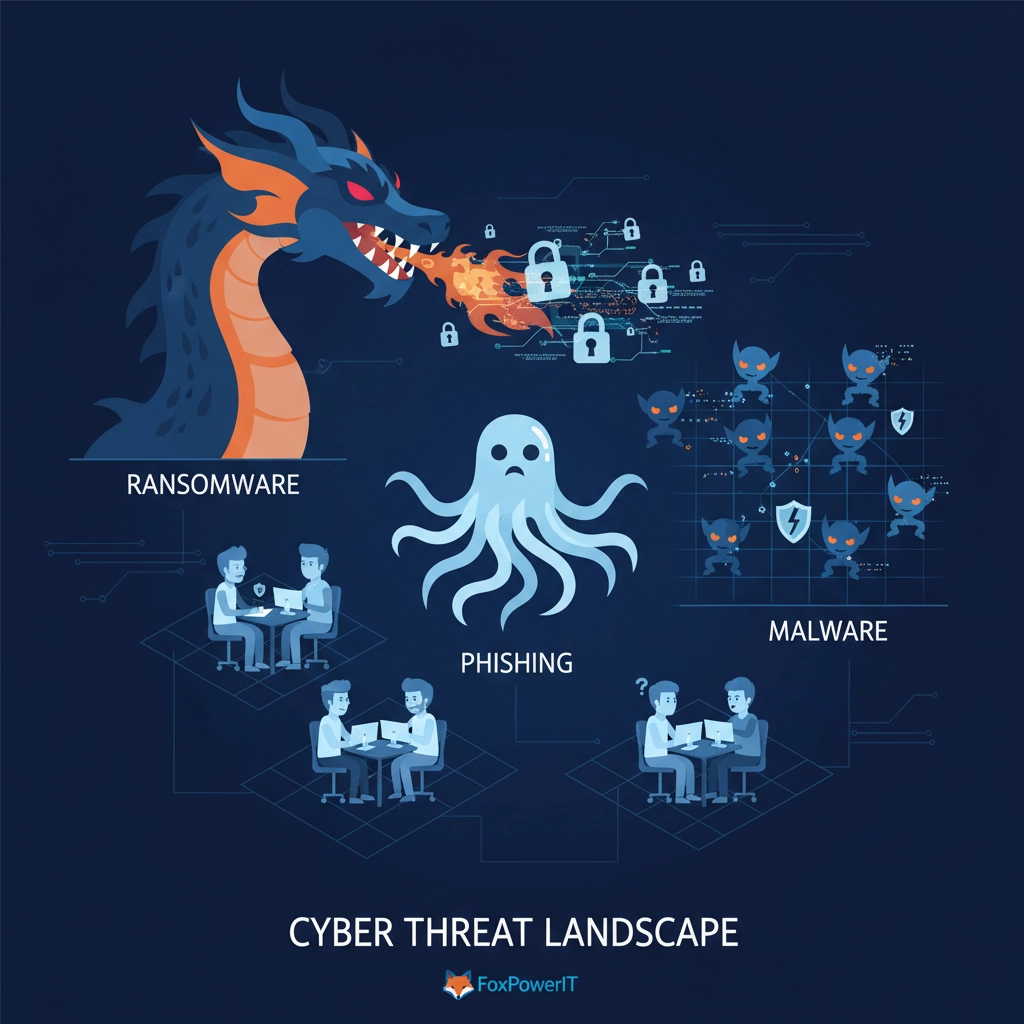The coffee shop WiFi password is "password123." Your employee just connected to it to finish a client proposal. Meanwhile, a cybercriminal sitting three tables away has intercepted that connection and is now browsing through your company's sensitive data. This scenario plays out hundreds of times daily across Connecticut, where small businesses are losing an average of $200,000 per data breach: enough to force many to permanently close their doors.
Connecticut's business landscape has fundamentally shifted. Manufacturing firms supporting defense contracts, insurance agencies, financial institutions, and healthcare providers now operate in a hybrid world where employees work from coffee shops, home offices, and co-working spaces. This flexibility has boosted productivity, but it's also created a cybersecurity nightmare that traditional IT security simply wasn't designed to handle.
The stakes couldn't be higher. Since the pandemic began, cybercrime has increased by 300%, with small businesses becoming the preferred target due to their minimal IT resources and basic security protocols. Connecticut companies are particularly attractive to cybercriminals who use them as stepping stones to reach larger organizations in their supply chains.
The Connecticut Cybersecurity Reality Check

Connecticut small businesses face three primary cyber threat categories that demand immediate attention. Understanding these threats is the first step toward building an effective defense strategy that protects both your business and your customers' sensitive information.
Phishing and Social Engineering: The Human Vulnerability
Phishing has evolved far beyond those obvious "Nigerian prince" emails. Today's attackers craft highly personalized messages that would fool even security-conscious employees. Spear phishing uses information gathered from social media and company websites to create emails that appear to come from trusted colleagues, vendors, or clients. These messages often contain urgent requests for sensitive information or ask employees to click malicious links.
Vishing (voice phishing) campaigns target employees through phone calls, with attackers impersonating IT support staff, bank representatives, or even executives requesting urgent access to systems or sensitive information. Smishing uses text messages to trick employees into revealing passwords and login credentials, often by creating a sense of urgency around account security or system updates.
The most dangerous aspect of social engineering is how it exploits trust relationships. Attackers research your organization structure, identify key employees, and craft scenarios that seem completely legitimate. A receptionist receives a call from someone claiming to be the IT manager, urgently needing the WiFi password for a "critical system update." A finance manager gets an email that appears to come from the CEO, requesting an immediate wire transfer for a "confidential acquisition."
Ransomware: The Business Killer
Ransomware attacks have become increasingly sophisticated and targeted. Connecticut businesses are particularly vulnerable because many lack comprehensive backup strategies and incident response plans. Modern ransomware doesn't just encrypt files: it steals sensitive data first, creating a double extortion scenario where attackers threaten to release confidential information if ransom demands aren't met.
Supply chain vulnerabilities compound this risk. Cybercriminals often target smaller Connecticut businesses specifically because they provide access to larger organizations. A small accounting firm serving multiple clients becomes a gateway to dozens of businesses. A manufacturing supplier with defense contracts becomes a national security concern.
The Remote Work Attack Surface
Remote work has exponentially increased the potential entry points for cybercriminals. Unsecured home WiFi networks, personal devices used for business purposes, and cloud applications accessed from multiple locations create a complex web of vulnerabilities that traditional perimeter security cannot address.
Weak passwords remain a fundamental vulnerability, with employees often reusing the same credentials across multiple personal and business accounts. When one account gets compromised, attackers can access everything else using those same credentials. This is particularly dangerous when employees use personal email accounts for business communications or access business applications through personal devices.
Building Your Defense Strategy

Protecting your Connecticut business requires a layered approach that addresses both technical vulnerabilities and human factors. The most effective security strategies combine multiple defensive measures to create overlapping protection that stops attacks even when individual components fail.
Multi-Factor Authentication: Your First Line of Defense
Multi-Factor Authentication (MFA) provides critical protection by requiring users to prove their identity using multiple verification methods. Even if a cybercriminal obtains an employee's password, they cannot access systems without the second authentication factor: typically a code sent to a mobile device or generated by an authenticator app.
Implementing MFA across all business systems, from email and cloud storage to financial applications and customer databases, creates an immediate barrier that stops the majority of unauthorized access attempts. Modern MFA solutions use biometric authentication, push notifications, and hardware tokens to make the process seamless for legitimate users while maintaining strong security.
Strong password policies must complement MFA implementation. Passwords should contain a mix of uppercase and lowercase letters, numbers, and special characters, with minimum length requirements of at least 12 characters. More importantly, employees need password managers that generate unique, complex passwords for each account and store them securely.
Secure Network Connections
Virtual Private Networks (VPNs) create encrypted tunnels that protect data transmission between remote workers and business systems. However, not all VPNs provide equal protection. Business-grade VPN solutions offer advanced features like kill switches that automatically disconnect internet access if the VPN connection fails, preventing data from transmitting over unsecured connections.
Split tunneling capabilities allow organizations to route only business traffic through the VPN while permitting personal internet usage through the regular connection. This approach improves performance while maintaining security for sensitive business communications and reduces the load on company network infrastructure.
Zero Trust network architecture takes security a step further by verifying every user and device before granting access to any resources. Unlike traditional security models that trust users once they're inside the corporate network, Zero Trust continuously validates access requests and monitors user behavior for suspicious activities.
Endpoint Protection and Management

Every device that accesses business data becomes a potential entry point for cybercriminals. Comprehensive endpoint protection goes beyond traditional antivirus software to include advanced threat detection, behavioral analysis, and automated response capabilities. Modern solutions use artificial intelligence to identify and stop previously unknown malware variants and zero-day exploits.
Mobile Device Management (MDM) policies ensure that smartphones and tablets used for business purposes meet security requirements. MDM solutions can enforce encryption, require screen locks, automatically update security patches, and remotely wipe business data if devices are lost or stolen. These policies must balance security requirements with employee privacy concerns and usability needs.
Bring Your Own Device (BYOD) frameworks allow employees to use personal devices while maintaining security standards. Effective BYOD policies define which devices are acceptable, require security software installation, and establish clear boundaries between personal and business data. Container-based solutions create secure workspaces on personal devices that isolate business applications and data from personal content.
Advanced Protection Strategies for 2025
The cybersecurity landscape continues evolving rapidly, with artificial intelligence and machine learning transforming both attack methods and defensive capabilities. Connecticut businesses that want to stay ahead of emerging threats need to adopt next-generation security technologies and strategies.
AI-Powered Threat Detection
Artificial intelligence has revolutionized cybersecurity by enabling real-time analysis of vast amounts of network traffic, user behavior, and system activities. AI-driven threat detection systems can identify subtle patterns that indicate potential attacks, often catching threats that traditional signature-based security tools miss entirely.
Behavioral analytics create baseline profiles of normal user and system activities, then flag unusual patterns that might indicate compromised accounts or insider threats. For example, if an employee who typically accesses files during business hours suddenly begins downloading large amounts of data at 3 AM from an unusual location, the system automatically triggers security alerts and can temporarily restrict access until the activity is verified.
Machine learning algorithms continuously improve threat detection by analyzing new attack patterns and updating defensive measures automatically. This adaptive approach is crucial for stopping zero-day exploits and advanced persistent threats that use novel techniques to avoid detection.
Cloud Security Architecture

As Connecticut businesses increasingly rely on cloud-based applications and storage, securing these environments becomes critical. Cloud Access Security Brokers (CASB) provide visibility and control over cloud application usage, enforcing security policies and preventing data loss through unauthorized cloud services.
Data Loss Prevention (DLP) solutions monitor sensitive information across all business systems, preventing accidental or intentional data breaches. These tools can identify Social Security numbers, credit card data, medical records, and other sensitive information, then automatically apply appropriate protection measures like encryption or access restrictions.
Identity and Access Management (IAM) systems provide centralized control over user permissions across all business applications. Single Sign-On (SSO) capabilities allow employees to access multiple applications with one set of credentials while giving administrators granular control over who can access what information.
Integrated Security Operations
Security Information and Event Management (SIEM) platforms aggregate security data from all business systems, providing comprehensive visibility into potential threats. Modern SIEM solutions use correlation rules and machine learning to identify attack patterns that span multiple systems and timeframes.
Automated incident response capabilities can immediately contain threats without waiting for human intervention. When suspicious activities are detected, automated systems can isolate affected devices, revoke user access, and initiate recovery procedures while alerting security personnel for further investigation.
Employee Training: Your Human Firewall
Technology alone cannot protect against cyber threats: employees need the knowledge and skills to recognize and respond appropriately to security incidents. Effective security awareness training goes beyond annual seminars to create an ongoing culture of cybersecurity vigilance.
Realistic Phishing Simulations
Simulated phishing campaigns test employee awareness by sending fake phishing emails that mimic real-world attack techniques. These simulations should be challenging but educational, helping employees learn to identify suspicious messages without creating fear or embarrassment around mistakes.
Progressive training programs start with obvious phishing attempts and gradually increase sophistication as employee awareness improves. Employees who fall for simulated phishing attempts receive immediate, constructive feedback and additional training resources rather than punitive measures.
Security Incident Response Training
Employees need clear, simple procedures for reporting suspected security incidents. Response training should cover what constitutes a potential security incident, whom to contact, and what immediate steps to take to limit potential damage.
Regular tabletop exercises simulate various security scenarios, allowing teams to practice their response procedures in a low-stress environment. These exercises identify gaps in incident response plans and provide opportunities for improvement before real emergencies occur.
Implementation Roadmap for Connecticut Businesses
Successfully implementing comprehensive remote work security requires careful planning and phased deployment. The following roadmap provides a practical approach for Connecticut small businesses to systematically strengthen their cybersecurity posture without overwhelming their IT resources or disrupting business operations.
Phase 1: Foundation Security (Months 1-2)
Begin with fundamental security measures that provide immediate protection. Implement multi-factor authentication across all business-critical systems, starting with email, banking, and cloud storage platforms. Deploy business-grade antivirus software on all company devices and establish automatic update procedures for operating systems and applications.
Conduct a comprehensive inventory of all devices, applications, and data storage locations used by employees. This inventory becomes the foundation for all subsequent security measures and helps identify potential vulnerabilities that need immediate attention.
Phase 2: Network Security (Months 3-4)
Deploy VPN solutions for all remote workers and establish secure WiFi networks in office locations. Implement network segmentation to isolate critical business systems from general internet access and employee devices.
Establish secure backup procedures with both local and cloud-based storage options. Test backup restoration procedures to ensure data can be quickly recovered in case of ransomware or hardware failures.
Phase 3: Advanced Protection (Months 5-6)
Implement advanced threat detection and response capabilities, including behavioral analytics and automated incident response. Deploy cloud security tools and establish comprehensive monitoring across all business systems.
Begin comprehensive employee security training programs with ongoing phishing simulations and incident response exercises. Create clear security policies and procedures that employees can easily understand and follow.
Ready to secure your Connecticut business against today's cyber threats? The team at FoxPowerIT specializes in helping small and medium businesses implement comprehensive remote work security strategies. From initial security assessments to ongoing managed security services, we provide the expertise and support you need to protect your business, employees, and customers from evolving cyber risks.
Don't wait until after a security incident to take action. Contact us today to schedule a security consultation and learn how we can help strengthen your cybersecurity posture while maintaining the flexibility and productivity that remote work provides. Your business's future depends on the security decisions you make today.

